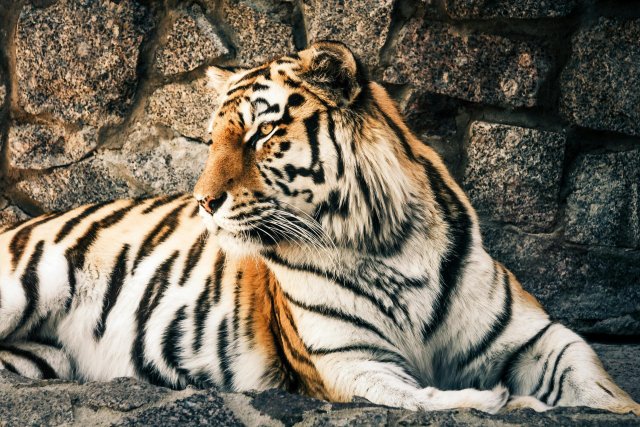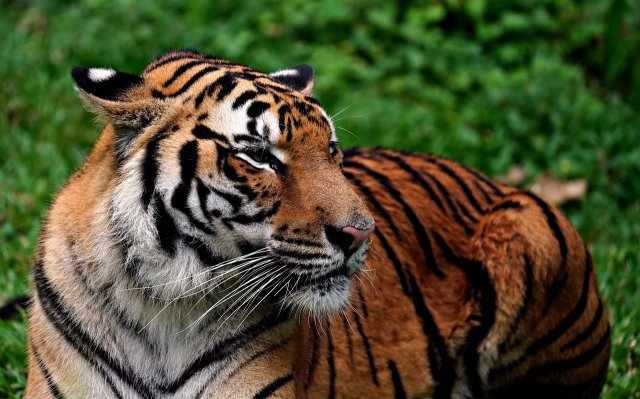Unleashing the Fierce Beauty: Exploring the Mesmerizing Tiger Stripe Patterns
5 Unique Tiger Stripe Patterns: Their Distinctive Stripes
 Tigers are known for their majestic appearance and distinctive stripes. These patterns not only make them visually appealing but also serve important purposes in their natural habitat. In this article, we will explore five unique tiger stripe patterns and delve into the reasons behind their distinctiveness.
Tigers are known for their majestic appearance and distinctive stripes. These patterns not only make them visually appealing but also serve important purposes in their natural habitat. In this article, we will explore five unique tiger stripe patterns and delve into the reasons behind their distinctiveness.
The Bengal Tiger: Classic and Iconic
The Bengal tiger, also known as the Royal Bengal tiger, is one of the most recognizable tiger species. Its stripe pattern consists of bold, black stripes that are evenly spaced across its orange or yellowish coat. These stripes are not only visually striking but also play a crucial role in the tiger’s survival.
The distinctive stripe pattern of the Bengal tiger serves as camouflage in its natural habitat, which primarily includes grasslands and forests. The vertical stripes help the tiger blend into the tall grasses, making it difficult for prey to spot them. Additionally, the stripes break up the tiger’s outline, making it harder for predators to detect them.
Research has shown that the width and spacing of the stripes vary among individual Bengal tigers. This uniqueness in their stripe patterns helps researchers identify and track individual tigers in the wild, aiding in conservation efforts.
The Malayan Tiger: Dark and Mysterious
The Malayan tiger, native to the Malay Peninsula, possesses a unique stripe pattern that sets it apart from other tiger species. Its stripes are narrower and closer together compared to the Bengal tiger. The dark, almost black stripes contrast against its reddish-orange coat, giving it a mysterious and captivating appearance.
The dense forests and jungles of the Malay Peninsula are the natural habitat of the Malayan tiger. The narrower stripes help the tiger blend into the dense vegetation, providing excellent camouflage during hunting. The dark coloration of the stripes also aids in hiding the tiger’s presence, making it a formidable predator.
Unfortunately, the Malayan tiger is critically endangered, with only a few hundred individuals remaining in the wild. Conservation efforts are crucial to protect this unique tiger species and preserve its distinctive stripe pattern for future generations.
The Siberian Tiger: Pale and Majestic
The Siberian tiger, also known as the Amur tiger, is the largest tiger species and inhabits the forests of eastern Russia. Its stripe pattern differs from other tiger species, with paler and more widely spaced stripes. The stripes are often a lighter shade of orange or brown, contrasting against its thick fur.
The Siberian tiger’s unique stripe pattern is well-suited for its snowy habitat. The paler stripes help the tiger blend into the snowy landscape, providing effective camouflage during winter months. This adaptation allows the Siberian tiger to stalk its prey unnoticed, increasing its chances of a successful hunt.
Due to habitat loss and poaching, the Siberian tiger is also endangered. Conservation efforts are crucial to protect this majestic species and preserve its distinctive stripe pattern.
The Sumatran Tiger: Dark and Striking
The Sumatran tiger, found only on the Indonesian island of Sumatra, possesses a distinct stripe pattern that sets it apart from other tiger species. Its stripes are darker and more closely spaced, giving it a bold and striking appearance.
The dense rainforests of Sumatra provide the Sumatran tiger with a habitat where its dark stripe pattern is advantageous. The dark stripes help the tiger blend into the shadows and undergrowth, making it difficult for prey to detect its presence. This adaptation allows the Sumatran tiger to ambush its prey effectively.
Unfortunately, the Sumatran tiger is critically endangered, primarily due to habitat loss and poaching. Conservation efforts are crucial to protect this unique tiger species and preserve its distinctive stripe pattern.
The South China Tiger: Few and Vanishing
The South China tiger, also known as the Chinese tiger, is one of the most endangered tiger species in the world. Its stripe pattern is similar to that of the Bengal tiger, with bold, black stripes against an orange or yellowish coat.
Historically, the South China tiger inhabited the forests of southern China. However, due to habitat loss and poaching, it is now considered functionally extinct in the wild. Efforts are being made to reintroduce captive-bred individuals back into their natural habitat, but the future of this unique tiger species remains uncertain.
Summary
Tiger stripe patterns are not only visually appealing but also serve important purposes in the tigers’ natural habitats. The Bengal tiger’s classic and iconic stripes provide camouflage, while the Malayan tiger’s dark and mysterious stripes aid in hiding. The Siberian tiger’s pale and majestic stripes blend into snowy landscapes, and the Sumatran tiger’s dark and striking stripes help it ambush prey effectively. Unfortunately, the South China tiger’s distinctive stripes may soon vanish due to its critically endangered status.
Understanding and appreciating these unique tiger stripe patterns is crucial for their conservation. By protecting their habitats and combating poaching, we can ensure the survival of these magnificent creatures and preserve their distinctive stripes for generations to come.
Discover the Untamed Beauty of Big Cats: Explore the Enchanting Stories of Big Cat Rescue




